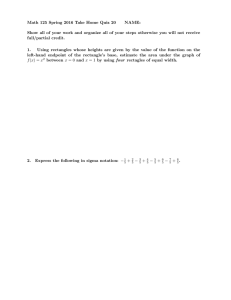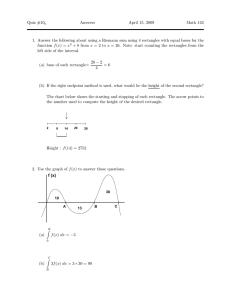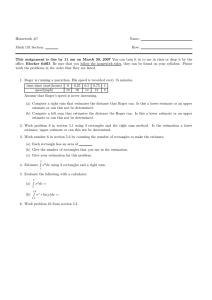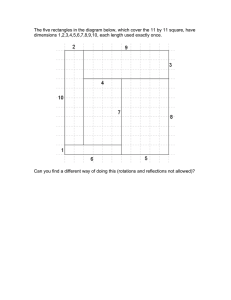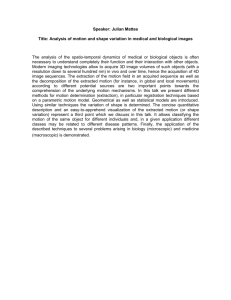PARAMETER ESTIMATION FOR A MARKED POINT PROCESS WITHIN A
advertisement
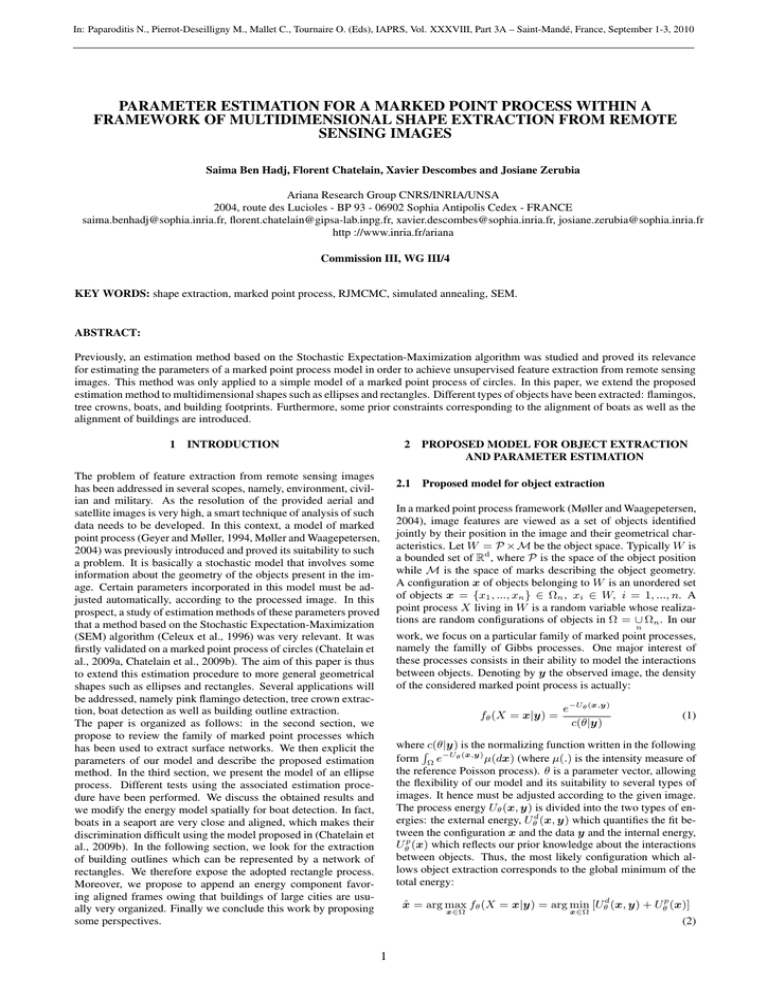
In: Paparoditis N., Pierrot-Deseilligny M., Mallet C., Tournaire O. (Eds), IAPRS, Vol. XXXVIII, Part 3A – Saint-Mandé, France, September 1-3, 2010
PARAMETER ESTIMATION FOR A MARKED POINT PROCESS WITHIN A
FRAMEWORK OF MULTIDIMENSIONAL SHAPE EXTRACTION FROM REMOTE
SENSING IMAGES
Saima Ben Hadj, Florent Chatelain, Xavier Descombes and Josiane Zerubia
Ariana Research Group CNRS/INRIA/UNSA
2004, route des Lucioles - BP 93 - 06902 Sophia Antipolis Cedex - FRANCE
saima.benhadj@sophia.inria.fr, florent.chatelain@gipsa-lab.inpg.fr, xavier.descombes@sophia.inria.fr, josiane.zerubia@sophia.inria.fr
http ://www.inria.fr/ariana
Commission III, WG III/4
KEY WORDS: shape extraction, marked point process, RJMCMC, simulated annealing, SEM.
ABSTRACT:
Previously, an estimation method based on the Stochastic Expectation-Maximization algorithm was studied and proved its relevance
for estimating the parameters of a marked point process model in order to achieve unsupervised feature extraction from remote sensing
images. This method was only applied to a simple model of a marked point process of circles. In this paper, we extend the proposed
estimation method to multidimensional shapes such as ellipses and rectangles. Different types of objects have been extracted: flamingos,
tree crowns, boats, and building footprints. Furthermore, some prior constraints corresponding to the alignment of boats as well as the
alignment of buildings are introduced.
1 INTRODUCTION
2 PROPOSED MODEL FOR OBJECT EXTRACTION
AND PARAMETER ESTIMATION
The problem of feature extraction from remote sensing images
has been addressed in several scopes, namely, environment, civilian and military. As the resolution of the provided aerial and
satellite images is very high, a smart technique of analysis of such
data needs to be developed. In this context, a model of marked
point process (Geyer and Møller, 1994, Møller and Waagepetersen,
2004) was previously introduced and proved its suitability to such
a problem. It is basically a stochastic model that involves some
information about the geometry of the objects present in the image. Certain parameters incorporated in this model must be adjusted automatically, according to the processed image. In this
prospect, a study of estimation methods of these parameters proved
that a method based on the Stochastic Expectation-Maximization
(SEM) algorithm (Celeux et al., 1996) was very relevant. It was
firstly validated on a marked point process of circles (Chatelain et
al., 2009a, Chatelain et al., 2009b). The aim of this paper is thus
to extend this estimation procedure to more general geometrical
shapes such as ellipses and rectangles. Several applications will
be addressed, namely pink flamingo detection, tree crown extraction, boat detection as well as building outline extraction.
The paper is organized as follows: in the second section, we
propose to review the family of marked point processes which
has been used to extract surface networks. We then explicit the
parameters of our model and describe the proposed estimation
method. In the third section, we present the model of an ellipse
process. Different tests using the associated estimation procedure have been performed. We discuss the obtained results and
we modify the energy model spatially for boat detection. In fact,
boats in a seaport are very close and aligned, which makes their
discrimination difficult using the model proposed in (Chatelain et
al., 2009b). In the following section, we look for the extraction
of building outlines which can be represented by a network of
rectangles. We therefore expose the adopted rectangle process.
Moreover, we propose to append an energy component favoring aligned frames owing that buildings of large cities are usually very organized. Finally we conclude this work by proposing
some perspectives.
2.1
Proposed model for object extraction
In a marked point process framework (Møller and Waagepetersen,
2004), image features are viewed as a set of objects identified
jointly by their position in the image and their geometrical characteristics. Let W = P × M be the object space. Typically W is
a bounded set of Rd , where P is the space of the object position
while M is the space of marks describing the object geometry.
A configuration x of objects belonging to W is an unordered set
of objects x = {x1 , ..., xn } ∈ Ωn , xi ∈ W, i = 1, ..., n. A
point process X living in W is a random variable whose realizations are random configurations of objects in Ω = ∪ Ωn . In our
n
work, we focus on a particular family of marked point processes,
namely the familly of Gibbs processes. One major interest of
these processes consists in their ability to model the interactions
between objects. Denoting by y the observed image, the density
of the considered marked point process is actually:
fθ (X = x|y) =
e−Uθ (x,y)
c(θ|y)
(1)
whereRc(θ|y) is the normalizing function written in the following
form Ω e−Uθ (x,y) µ(dx) (where µ(.) is the intensity measure of
the reference Poisson process). θ is a parameter vector, allowing
the flexibility of our model and its suitability to several types of
images. It hence must be adjusted according to the given image.
The process energy Uθ (x, y) is divided into the two types of energies: the external energy, Uθd (x, y) which quantifies the fit between the configuration x and the data y and the internal energy,
Uθp (x) which reflects our prior knowledge about the interactions
between objects. Thus, the most likely configuration which allows object extraction corresponds to the global minimum of the
total energy:
x̂ = arg max fθ (X = x|y) = arg min [Uθd (x, y) + Uθp (x)]
x∈Ω
1
x∈Ω
(2)
In: Paparoditis N., Pierrot-Deseilligny M., Mallet C., Tournaire O. (Eds), IAPRS, Vol. XXXVIII, Part 3A – Saint-Mandé, France, September 1-3, 2010
2.2
Algorithmically, the computation of the global minimum of this
energy is performed by a simulated annealing scheme (Azencott,
1992).
Before revealing the proposed estimation method, it is necessary
to identify the parameters to be estimated. The parameter vector θ embedded in the considered model is composed of: the
activity parameter β, the maximal overlapping ratio s, the data
energy weight γd , the threshold d0 involved in the quality function and the width of the boundary of an object ρ. Some of these
parameters can be set in a deterministic way as they have an intuitive interpretation: The boundary width ρ is usually set to 1 or
2, the threshold s is set as the tolerated recovery proportion between objects. The previous study of the model parameters has
shown that the activity parameter β and the weight parameter γd
are correlated. The experience proved that a low value of β is
compensated by a high value of γd and vice versa. Therefore,
we decide to estimate only one parameter which is the weight γd
and set manually the other ones. The problem of parameter estimation consists in identifying the most likely parameter vector θ
that maximizes the image likelihood fθ (y). As the density of the
observation fθ (y) is unknown, we propose to maximize the extended likelihood fθ (x, y). However, the configuration x is likewise unknown. The study of estimation methods (Chatelain et
al., 2009a) showed that the stochastic version of the ExpectationMaximization (SEM) algorithm (Celeux et al., 1996) is very relevant in such a situation. It consists in iterating the three following
steps:
2.1.1 Data energy Two main approaches for computing the
data energy term were previously introduced to extract surface
networks (Chatelain et al., 2009a). The first one was carried out
in a Bayesian framework. Nevertheless, it doesn’t sufficiently
take into account the morphology of objects. The second one is
more efficient. It consists in defining a local energy Uθd (u) ∈
[−1, 1] associated with each object u. Then, the data energy associated with a configuration x is proportional to the sum of all
the local energies computed on each object u of x:
X d
Uθd (x, y) = γd
Uθ (u, y)
(3)
u∈x
where the parameter γd > 0 corresponds to the data energy
weight. Its definition relies on a contrast measure between the
distribution of the set of pixels belonging to an object u and the
distribution of pixels belonging to its border F ρ (u). The data energy Uθd (u) is built as a qualification of this contrast measure in
order to promote well-placed objects and penalize bad ones:
Uθd (u) = Q(
d(u, F ρ (u))
)
d0
Estimation algorithm
(4)
where d(u, F ρ (u)) is the Bhattacharya distance between the object u and its boundary F ρ (u). Qd0 : R+ 7→ [−1, 1] is a quality
function. It attributes a negative value to objects that have a high
radiometric distance w.r.t. their border (i.e. d(u, F ρ (u)) is above
the threshold d0 ) and a positive value otherwise:
1 − x1/3
if x < 1,
(5)
Q(x) =
x−1
exp(−
) − 1 if x ≥ 1.
3
1. S step: Simulate a configuration of objects:
x(k) ∼ fθk (X/y)
(8)
2. E Step: Evaluate the extended log-likelihood:
Q(θ, θk ; y) = log fθ (x(k) , y)
(9)
3. M step: Maximize the log-likelihood:
Using a cubic root in this quality function ensures a moderate penalization when the distance d(u, F ρ (u)) is close to the threshold
d0 . To illustrate the behavior of such a function, we give its plot
in figure 2(left).
θk+1 = arg max Q(θ, θk ; y)
θ∈Θ
(10)
Nevertheless, the E step is unreachable as the extended density
fθ (x(k) , y) is not tractable (the normalizing constant is inaccessible). To overcome this difficulty, we propose to approximate the
extended likelihood by the pseudo-likelihood (Besag, 1975, Baddeley and Turner, 2000). Its expression in the case of incomplete
data is given by:
µ Z
¶
P LW (θ; x, y) = exp −
λθ (u; x, y)Λ(du) ×
W
(11)
Y
λθ (xi ; x, y)
2.1.2 Prior energy This energy corresponds to a penalization
of the overlapping objects and thus avoids detecting the same object several times. For this purpose, we define the neighborhood
system corresponding to overlapping objects by the following relationship:
Area(xi ∩ xj )
<s
min(Area(xi ), Area(xj ))
(6)
The parameter s ∈ [0, 1] represents the maximum recovery ratio
between two objects. Afterwards, we introduce a “Hard Core”
process which penalizes any configuration having at least one
overlapping object pair with a recovery rate exceeding a threshold s. The non-normalized density of such a process is written
as follows: hβ,γ (x) = β n(x) e−Us (x) where β is the activity
parameter, n(x) is the
P number of objects in the configuration x
and Us (x) =
ts (xi , xj ) is the interaction potential
∀xi , xj ∈ W, xi ∼ xj ⇐⇒
xi ∈x
where λθ is the extended Papangelou intensity which can be written as follows:
X
λθ (u; x, y) = β exp −γd Ud (u) −
ts (u, xi )
xi ∈x/xi 6=u
(12)
In practice, the simulation step is performed using a Reversible
Jump Metropolis-Hastings algorithm (Green, 1995) or a multiple
births and deaths algorithm. Afterwards, the maximization step is
performed using the Nelder-Mead Simplex algorithm. The SEM
algorithm is supposed to converge when the parameter vector remains stable. Once the parameters are estimated, we determine
the most likely object configuration that maximizes the energy
model thanks to a simulated annealing algorithm.
1<i<j<n(x)
of objects in x. The interaction function between object pairs
ts (xi , xj ) can be written as follows:
(
0
if xi ∼ xj ,
ts (xi , xj ) =
(7)
+∞ otherwise.
By assigning an infinite energy to object pair that does not interact
according to ∼, the associated probability is practically zero.
2
In: Paparoditis N., Pierrot-Deseilligny M., Mallet C., Tournaire O. (Eds), IAPRS, Vol. XXXVIII, Part 3A – Saint-Mandé, France, September 1-3, 2010
3
3.1
ELLIPSE MODEL
image (see figure 1(left)), 25 min for the tree image (see figure
4(left)) and 1 h and 36 min for the boat image (see figure 5(top)).
The set of ellipses obtained at the convergence of the SEM algorithm for the flamingo image is revealed by the figure 3(right).
After estimating the data weight, objects are extracted thanks to a
simulated annealing algorithm. The estimates as well as the configurations of ellipses corresponding to the flamingo extraction,
tree crown extraction and ship detection are respectively depicted
in figures 3(right), 4(right) and 5(bottom). These results show
that the proposed approach is very relevant for flamingo and tree
crown extraction but does not fit the problem of boat detection.
Therefore, we suggest in the second paragraph to modify the proposed model for the boat image. Moreover, to assess the accuracy
of our solution, we have manually generated the ground truth of
the flamingo image: the red ellipses are those that are automatically generated; the black ones are those that are supposed to
appear (7 false negatives), the crossed red ellipses correspond to
those that are wrongly detected (4 false positives) and all the red
ellipses which have a blue point in their midst are considered as
correct. From these results we compute the f-measure which is
0.98 and thus we conclude that our solution is very accurate (remark that an error up to 5% is acceptable for ecologists). Besides, the given results are only for one run, the table 1 gives an
idea about the computational time average of several runs, the
estimate mean γd and the standard deviation E [γd ].
From circles to ellipses
Firstly, the estimation method was validated for a simple model of
marked point process where the objects were circular (Chatelain
et al., 2009b). Only one object mark corresponding to the radius
of circles was introduced. The simulation results of the proposed
approach on a 274 × 269 image of a flamingo colony in Camargue in France were not quite satisfactory (see figure 1). One can
c
Figure 1: left: flamingo colony in Camargue, France °Tour
de
Valat, right: flamingo extraction using a circle model: 363 circles
c
°INRIA
(β = 1000, γd = 13.88, s = 0.3, d0 = 1.33).
notice misdetections on figure 1(right). Thus, such a model does
not deal very well with the problem of flamingo extraction. A
model of an ellipse process may be more suitable to the flamingo
shape. This process is defined on the following object space:
W = [0, Xmax ]×[0, Ymax ]×[amin , amax ]×[bmin , bmax ]×[0, π[
which corresponds to the parameterization space of an ellipse u
defined by five variables u = (x, y, a, b, ω). amax and amin
are the parameters that demarcate the space of the semi-major
axis a, and bmax and bmin are the parameters corresponding
to the definition domain of the semi-minor axis b. The figure
2(right) illustrates such a parameterization. This makes the esti-
Figure 3: left: simulation step of the SEM algorithm, right:
c
flamingo extraction using an ellipse model 387 ellipses °INRIA
(β = 1000, γd = 16.25, s = 0.3, d0 = 1.33)
1
0.8
0.6
0.4
Q
0.2
0
−0.2
−0.4
−0.6
−0.8
−1
0
2
4
6
8
10
x
Figure 2: left: quality function, right: ellipse parameterization.
mation algorithm time consuming since the number of parameters
is increased using the ellipse process.
3.2
c
Figure 4: left: plantation in Saone et Loire °IFN,
right: tree
c
crown extraction using an ellipse model: 598 ellipses °INRIA,
(β = 1000, γd = 15.14, s = 0.2, d0 = 2).
Validation of the ellipse model
In order to validate the proposed estimation method associated
with an ellipse process, we tested it on three types of images;
the flamingo image considered in the former paragraph, an image of trees in Saone-et-Loire of 229 × 196 pixels (figure 4(left))
and an image of boats of 385 × 275 pixels (figure 5(top)). For
each image, we outfaced a new object structure. We manually
initialized some parameters. The activity parameter was set as an
over-estimation of the number of objects in the image, β = 1000
for all the treated images. The maximum overlapping rate was set
to s = 0.3. All our simulations were performed using a processor
with 1.86 GHz frequency. The estimation algorithm appears to
be computationally expensive. It lasted 12 min for the flamingo
Mean time
γd
E [γd ]
Flamingo image
41 min
17.87
2.5813
Tree image
24 min
14.85
0.5469
Boat image
1h and 41 min
38.62
0.5427
Table 1: Statistical results
3.3 Modification of the energy model for boat detection
As the boats of the image 5(top) are very close, the border F ρ (u)
of an object u is not homogenous. That is why, we modify its definition and we consider that it corresponds to the two ends of the
3
In: Paparoditis N., Pierrot-Deseilligny M., Mallet C., Tournaire O. (Eds), IAPRS, Vol. XXXVIII, Part 3A – Saint-Mandé, France, September 1-3, 2010
circumscribed crown (figure 6(left)). The corresponding SEM algorithm led to the estimate γd = 11.9512. The extraction results
displayed in figure 7 are enhanced, compared to those of the figure 5(bottom). However, some false-detections corresponding to
not aligned ellipses remained. To avoid this problem, we propose
to favor close and aligned ellipses. For this purpose, we define an
alignment interaction ∼al between two ellipses (figure 6(right))
as follows:
dω (e1 , e2 ) ≤ dωmax
e1 ∼al e2 ⇐⇒ dα (e1 , e2 ) ≤ dαmax
(13)
d (e , e ) ≤ d
C 1 2
Cmax
Figure 6: left: new definition of the ellipse border, right: tangent
ellipses
where dω (e1 , e2 ) =| ω1 −ω2 | is the difference of the orientation
π
ω1 + ω2
+ )|
of ellipses e1 and e2 , and dα (e1 , e2 ) =| α − (
2
2
is a measure that checks that the ellipses are not shifted. Finally,
dC (e1 , e2 ) =| d(c1 , c2 ) − (b1 + b2 ) |, where d(c1 , c2 ) stands for
the Euclidian distance between the centers c1 and c2 of the two
ellipses e1 and e2 respectively. Then, we append a prior energy
that promotes two tangent ellipses as follows:
δ(dC (e1 , e2 ), dCmax ) .
Ual (e1 , e2 ) = $(dα (e1 , e2 ), dαmax ) if e1 ∼al e2 , (14)
0
otherwise.
Figure 7: Extraction results with modification of the data term:
635 ellipses (β = 1000, γd = 11.95, s = 0.3, d0 = 6).
where $(x, xmax ) is a reward function, previously introduced in
(Ortner et al., 2008) to favor aligned buildings:
·
¸
1 + x2max
1
−
1
, ∀ x ≤ xmax (15)
$(x, xmax ) = − 2
xmax
1 + x2
configuration x:
p
Ual
(x) = γal
X
Ual (ei , ej )
(16)
1<i<j<n(x)
It is negative, when the measure x is below the threshold xmax
and zero, if the measure x equals xmax . The weight δ is dependent on the distance between ellipses. It equals 1, when the
ellipses are too close and is close to zero, otherwise. Finally,
the prior energy of a configuration x, which corresponds to the
alignment constraint is the sum over all the object pairs of the
The weight γal is likewise a parameter of our model and must be
estimated by the SEM algorithm. The experience showed that a
value of γal lower than γd leads to good results for boat detection.
0
In our simulations, the initial value γal
used in the SEM algorithm
0
for the parameter γal is set to γal =γd0 /3, where γd0 is the initial
value for γd (see (Chatelain et al., 2009b) for more details on
the numerical evaluation of γd0 ). The estimation procedure converges after 1 h and 38 min and provides the following estimates:
γd = 25.3426 and γal = 10.535. The extraction results depicted
in figure 8 show that the ellipses are better organized. However,
Figure 8: Extraction results with an alignment constraint between ellipses: 715 ellipses (β = 1000, γd = 25.34, γal =
10.53, s = 0.3, d0 = 6).
one can notice some false-detections standing for aligned ellipses
that are placed on the same boat (the number of boats automatically estimated is 715 while the hand-counted number of boats is
570). Furthermore, introducing a repulsive energy that penalizes
not aligned ellipses does not enhance boat extraction results and
leads to several misdetections. Thus, in a similar way to (Perrin
et al., 2005), we propose to promote aligned ellipses that have a
particular orientation (which is denoted by ωN ), since the ships of
c
Figure 5: top: photograph of vessels in France °CNES,
bottom:
c
boat detection using an ellipse model 508 ellipses °INRIA
(β =
1000, γd = 38.65, s = 0.3, d0 = 6).
4
In: Paparoditis N., Pierrot-Deseilligny M., Mallet C., Tournaire O. (Eds), IAPRS, Vol. XXXVIII, Part 3A – Saint-Mandé, France, September 1-3, 2010
in (Ortner et al., 2008). We define two different relationships between building features; actually alignment and orthogonal interactions. In fact, orthogonal interaction is not viewed as a simple
rotation between two interacted frames since some constraints on
their appropriate edges must be taken into account as it will be
explained later.
the processed image have a common direction. Thus, we modify
the expression of the energy related to the alignment interactions
of an object e as follows:
(
p
p
Ual
(x ∪ {e}) − Ual
(x) if | ωe − ωN |≤ dωmax
Ualω (e) =
0
otherwise
(17)
In order to validate this idea, we empirically define the boat direction and we then simulate the SEM algorithm corresponding
to such a model. The estimates γd = 27.56 and γal = 9.18 contribute to the detection of 523 boats depicted in figure 9. The de-
4.3.1 Alignment interaction We say that the rectangle u is
aligned with the rectangle v, if one of its short edges is opposite
to one short edge of the second rectangle v (figure 11(middle)).
In other words, they are close enough such that the Euclidian
distance dC (i, j) between the corner i of the rectangle u and the
corner j of the rectangle v is low and their appropriate short edges
are opposite (i + j = 3) as well as they have almost the same
orientation such that their angle difference (modulo π) dω (u, v)
is low enough:
dC (i, j) ≤ dCm
u ∼ali v, ∀i ∈ {0, 1, 2, 3} ⇐⇒ dω (u, v) ≤ dωm
(18)
i + j = 3
Hence, the prior energy dealing with the alignment constraint is
built such that it attributes a negative value to the pair of objects
which exhibits jointly a low distance between their appropriate
extremities and a low angle difference:
1
1
2 $(dC (i, j), dCm ) + 2
Uali (u, v) = $(dω (u, v), dω )
if u ∼ali v (19)
m
0
otherwise
Figure 9: Extraction results favoring aligned ellipses having a
particular direction: 523 ellipses (β = 1000, γd = 27.56, γal =
9.18, s = 0.3, d0 = 6).
tection results are greatly improved. Nevertheless, this approach
is not useful when the boats do not have a common direction. In
this case, locally assessing the boat direction is a possible alternative.
where $ (x, xmax ) is a reward function given by equation (15).
Summing all the local energies over the object pairs of the configuration x, we actually obtain the alignment energy of the configuration x:
X
X
Ual (x) = γal
Uali (xj , xk )
(20)
4 RECTANGLE MODEL
4.1
From ellipses to rectangles
In this section, we are interested in a marked point process which
is defined in the following state space (a bounded set of R5 ):
1<j<k<n(x) 0≤i≤3
where γal is a regularization parameter that corresponds to the
alignment energy.
W = P × M =[1, Xmax ] × [1, Ymax ] × [lmin , lmax ]×
[Lmin , Lmax ] × [0, π[
where (lmin , lmax ) respectively stands for the minimum and the
maximum semi-width of the rectangle, (Lmin , Lmax ) are the
minimum and the maximum of its semi-length and ω ∈ [0, π[
is its orientation. This parameterization is illustrated in figure
11(left).
4.2
Validation of the rectangle model
We simulate the estimation procedure associated with the described rectangle model on the Digital Elevation Model (DEM)
of a part of Amiens image of 231 × 194 pixels, depicted on figure
10(left). Moreover, our tests were performed with the same CPU
used in the previous simulations (a processor with 1.86 GHz frequency). The estimate γd = 29.402 contributes to the configuration displayed in figure 10(right), obtained at the extraction
phase. Some rectangle pairs are not close enough and not very
well aligned which could account for some misdetections. To
overcome this problem, we propose to promote close and aligned
rectangles.
4.3
c
Figure 10: left: DEM of a part of Amiens °IGN,
right: building outline extraction using a rectangle model: 83 rectangles
c
°INRIA,
(β = 500, γd = 29.402, s = 0.2, d0 = 4).
Modification of the energy model for building outline
detection
Figure 11: left: rectangle parameterization, middle: aligned rectangles, right: orthogonal rectangles.
We propose to introduce an energy term that favors aligned and
close frames. We thus use a similar component to that involved
5
In: Paparoditis N., Pierrot-Deseilligny M., Mallet C., Tournaire O. (Eds), IAPRS, Vol. XXXVIII, Part 3A – Saint-Mandé, France, September 1-3, 2010
4.3.2 Orthogonal connection We propose to promote likewise orthogonal frames. In fact, two rectangles are said orthogonal, if one rectangle short side is opposite to the other rectangle
long side (figure 11(right)). That means, they satisfy the following conditions:
dC (i, j) ≤ dCm
u ∼orthi v, ∀i ∈ {0, 1, 2, 3} ⇐⇒ | dω (u, v) − π2 |≤ dωm
i + j = 0, 2, 4 or 6
(21)
By analogy with the expression (19) and (20), we define an energy component of a configuration x, related to orthogonal connections ∼orthi as follows:
X
X
Uorth (x) = γorth
Uorthi (xj , xk )
interest for estimating the parameters of an ellipse process within
the framework of flamingo and tree crown extraction. Its application to an image of boats in a seaport required the modification
of both the data energy and the prior energy components of the
proposed model. Moreover, in order to extract building footprint
in a dense urban area, we introduced an energy term providing
orthogonal and aligned frames. For that matter, we estimated by
the SEM algorithm a new parameter related to this type of interaction. Nevertheless, incorporating ellipse or rectangle process in
an iterative algorithm such as SEM algorithm is time consuming.
Accelerating the proposed algorithm by optimization strategies
could be a nice future work. The computation of the pseudolikelihood, representing more than 70% of the computation, could
be parallelized using a multi-threaded program. Besides, the direction of boats involved in the prior term was set manually. It
could be interesting to estimate it automatically.
1<j<k<n(x) 0≤i≤3
where γorth is the weight of the described energy. Having specified the different types of connections that link buildings of an
urban area, we can define an energy term that summarizes all
the interactions between rectangles representing buildings as follows:
p
p
Uθpint (x) = γint [Ual
(x) + Uorth
(x)]
(22)
ACKNOWLEDGEMENTS
The authors would like to thank the French Space Agency (CNES),
the French Forest Inventory (IFN) and Tour du Valat for providing the images presented in this paper. This research work has
been partially supported by INRIA through a post-doctoral grant
for the second author and partially by CNES through a contract.
A new parameter γint related to rectangle interactions is introduced in order to offset the value of the other parameters γal and
γorth which can be set to 1, since both alignment and orthogonal connections are present in an equitable manner in the image
10(left). Hence, we are interested in estimating only one interaction parameter which is the weight γint , by the SEM algorithm.
0
Moreover, we initialize this interaction weight to γint
= γd0 /2,
since the empirical test showed that it must have a lower value
than that of the data energy weight γd . The SEM estimation algorithm performed on the part of Amiens considered in the former test is very slow. It required 6 h and 21 min and contributed
to the following estimates γd = 30.0599 and γint = 16.8494.
The result of the extraction phase depicted in figure 12 shows that
the frames are closer and more aligned than those of the previous
simulation. However, some pairs are still distant. In fact, the dis-
REFERENCES
Azencott, R., 1992. Simulated annealing: Parallelization techniques. Wiley, NY, Springer-Verlag.
Baddeley, A. and Turner, R., 2000. Practical maximum pseudolikelihood for spatial point patterns. Australian and New Zealand
Journal of Statistics 42(3), pp. 283–322.
Besag, J., 1975. Statistical analysis of non-lattice data. The
Statistician 24(3), pp. 179–195.
Celeux, G., Chauveau, D. and Diebolt, J., 1996. Stochastic versions of the EM algorithm: An experimental study in the mixture
case. Journal of Statistical Computation and Simulation 55(4),
pp. 287–314.
Chatelain, F., Descombes, X. and Zerubia, J., 2009a. Estimation des paramètres de processus ponctuels marqués dans le
cadre de l’extraction d’objets en imagerie de télédétection. In:
GRETSI’09, Dijon, France.
Chatelain, F., Descombes, X. and Zerubia, J., 2009b. Parameter estimation for marked point processes. Application to object extraction from remote sensing images. In: EMMCVPR’09,
Springer-Verlag, Berlin, Heidelberg, pp. 221–234.
Geyer, C. and Møller, J., 1994. Simulation procedures and likelihood inference for spatial point processes. Scandinavian Journal
of Statistics 21(4), pp. 359–373.
Figure 12: Extraction results, favoring orthogonal and aligned
rectangles: 83 rectangles (β = 1000, γd = 30.05, γint =
16.84, s = 0.3, d0 = 4).
Green, P., 1995. Reversible jump Markov chain Monte Carlo
computation and Bayesian model determination. Biometrika
82(4), pp. 711–732.
tance between two remote objects cannot support a new object
without overlapping with them. To avoid such a case, we can increase the tolerated recovery rate s or we can employ object with
variable size allowing the presence of small and large rectangles.
In fact, in our tests we have limited the size of the occurred rectangles when we have set the object space parameters.
Møller, J. and Waagepetersen, R., 2004. Statistical inference and
simulation for spatial point processes. CRC Press.
Ortner, M., Descombes, X. and Zerubia, J., 2008. A marked point
process of rectangles and segments for automatic analysis of Digital Elevation Models. IEEE Transactions on Pattern Analysis and
Machine Intelligence 30(1), pp. 105–119.
5 CONCLUSION AND FUTURE WORK
Perrin, G., Descombes, X. and Zerubia, J., 2005. A Marked
Point Process Model for Tree Crown Extraction in Plantations.
In: Proc. IEEE International Conference on Image Processing
(ICIP), Genoa.
In this paper, we generalized the estimation method associated
with a marked point process model to the case of multidimensional shapes such as ellipses and rectangles. The proposed estimation method is based on the SEM algorithm. It showed its
6
